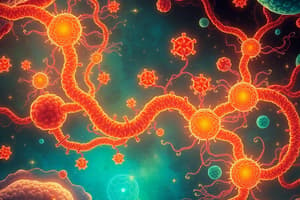Podcast
Questions and Answers
What is the primary function of glycolysis in cellular respiration?
What is the primary function of glycolysis in cellular respiration?
- Convert glucose into pyruvate while releasing energy (correct)
- Degrade fatty acids into glucose
- Transport ATP from mitochondria to the cytoplasm
- Synthesize glucose from pyruvate
How many ATP molecules are used during the initial steps of glycolysis?
How many ATP molecules are used during the initial steps of glycolysis?
- Two ATP molecules (correct)
- Four ATP molecules
- One ATP molecule
- Three ATP molecules
What is the first step of glycolysis known as?
What is the first step of glycolysis known as?
- Hydrolysis
- Reduction
- Phosphorylation (correct)
- Oxidation
What is produced by the oxidation of triose phosphate during glycolysis?
What is produced by the oxidation of triose phosphate during glycolysis?
What happens to the glucose molecule during glycolysis?
What happens to the glucose molecule during glycolysis?
What is the final product of glycolysis?
What is the final product of glycolysis?
Which process occurs when hydrogen is removed from triose phosphate?
Which process occurs when hydrogen is removed from triose phosphate?
What role does NAD play in glycolysis?
What role does NAD play in glycolysis?
What is the outcome of one glucose molecule undergoing glycolysis?
What is the outcome of one glucose molecule undergoing glycolysis?
During glycolysis, how is the energy initially utilized?
During glycolysis, how is the energy initially utilized?
What happens to NAD during the oxidation of triose phosphate?
What happens to NAD during the oxidation of triose phosphate?
What phosphorylated intermediate is formed after glucose phosphate in glycolysis?
What phosphorylated intermediate is formed after glucose phosphate in glycolysis?
What is produced alongside ATP during the conversion of triose phosphate to pyruvate?
What is produced alongside ATP during the conversion of triose phosphate to pyruvate?
How many molecules of reduced NAD are formed during glycolysis for each glucose molecule?
How many molecules of reduced NAD are formed during glycolysis for each glucose molecule?
In which part of the cell does glycolysis occur?
In which part of the cell does glycolysis occur?
What process occurs after fructose 1,6 bisphosphate is formed?
What process occurs after fructose 1,6 bisphosphate is formed?
Flashcards are hidden until you start studying
Study Notes
Glycolysis Overview
- Glycolysis is the biochemical pathway that breaks down glucose into pyruvate, occurring in the cytoplasm.
- A single glucose molecule (6 carbon atoms) is split into two pyruvate molecules (3 carbon atoms each).
Energy Investment Phase
- Initial steps consume energy, utilizing two ATP molecules to activate glucose for further reaction.
- The first step involves phosphorylation, where phosphate groups from ATP are transferred to glucose, forming glucose phosphate.
- Glucose phosphate is rearranged to produce fructose phosphate, which is then phosphorylated again to create fructose 1,6 bisphosphate.
Cleavage and Oxidation
- Fructose 1,6 bisphosphate is divided into two triose phosphate molecules.
- During the conversion of triose phosphate to pyruvate, hydrogen is removed and transferred to NAD, resulting in the formation of reduced NAD (NADH).
ATP Generation
- Two molecules of reduced NAD are generated from one glucose molecule.
- ATP is also produced through substrate-level phosphorylation during the conversion of triose phosphate to pyruvate.
- Four ATP molecules are generated at the end of glycolysis, leading to a net gain of two ATPs after accounting for the two ATPs consumed initially.
End Products and Further Metabolism
- The end product of glycolysis is pyruvate, which retains significant chemical potential energy.
- If oxygen is present, pyruvate is actively transported into the mitochondrion's matrix for further processing.
Glycolysis Overview
- Glycolysis is the biochemical pathway that breaks down glucose into pyruvate, occurring in the cytoplasm.
- A single glucose molecule (6 carbon atoms) is split into two pyruvate molecules (3 carbon atoms each).
Energy Investment Phase
- Initial steps consume energy, utilizing two ATP molecules to activate glucose for further reaction.
- The first step involves phosphorylation, where phosphate groups from ATP are transferred to glucose, forming glucose phosphate.
- Glucose phosphate is rearranged to produce fructose phosphate, which is then phosphorylated again to create fructose 1,6 bisphosphate.
Cleavage and Oxidation
- Fructose 1,6 bisphosphate is divided into two triose phosphate molecules.
- During the conversion of triose phosphate to pyruvate, hydrogen is removed and transferred to NAD, resulting in the formation of reduced NAD (NADH).
ATP Generation
- Two molecules of reduced NAD are generated from one glucose molecule.
- ATP is also produced through substrate-level phosphorylation during the conversion of triose phosphate to pyruvate.
- Four ATP molecules are generated at the end of glycolysis, leading to a net gain of two ATPs after accounting for the two ATPs consumed initially.
End Products and Further Metabolism
- The end product of glycolysis is pyruvate, which retains significant chemical potential energy.
- If oxygen is present, pyruvate is actively transported into the mitochondrion's matrix for further processing.
Studying That Suits You
Use AI to generate personalized quizzes and flashcards to suit your learning preferences.




